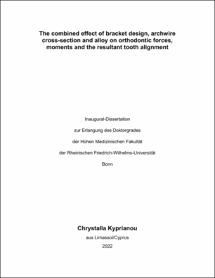Kyprianou, Chrystalla: The combined effect of bracket design, archwire cross-section and alloy on orthodontic forces, moments and the resultant tooth alignment. - Bonn, 2022. - Dissertation, Rheinische Friedrich-Wilhelms-Universität Bonn.
Online-Ausgabe in bonndoc: https://nbn-resolving.org/urn:nbn:de:hbz:5-66829
Online-Ausgabe in bonndoc: https://nbn-resolving.org/urn:nbn:de:hbz:5-66829
@phdthesis{handle:20.500.11811/9820,
urn: https://nbn-resolving.org/urn:nbn:de:hbz:5-66829,
author = {{Chrystalla Kyprianou}},
title = {The combined effect of bracket design, archwire cross-section and alloy on orthodontic forces, moments and the resultant tooth alignment},
school = {Rheinische Friedrich-Wilhelms-Universität Bonn},
year = 2022,
month = may,
note = {Aim: The purpose of the study was to determine the force and moment capacity, as well as the effectiveness of fully customised lingual brackets in comparison to labial bracket systems with the use of various wire types.
Materials and methods: Four bracket appliances were tested, two of which were fully customised lingual systems [Incognito™ (3M Unitek, Monrovia, Minnesota, USA) and WIN (DW Lingual Systems, Bad Essen, Germany)] and two conventional labial brackets [Discovery classic and Discovery smart bracket systems (Dentaurum, Ispringen, Germany)]. The appliances were combined with six archwire types [0.012”, 0.014”, 0.016”, 0.016” x 0.022” nickel titanium, 0.018” x 0.025” beta titanium and 0.018” x 0.025” stainless steel] and the different combinations were examined on three teeth [a lateral incisor (42), a canine (33) and a premolar (45)]. Alignment simulation and predefined wire activation protocols were utilised for this study.
Results: Forces ranged between 0.01N and 4,06N, whereas moments ranged between 0,16Nmm and 23,07Nmm. The fully customised lingual systems generated higher forces during intrusion/extrusion when combined with 0.016” x 0.022” NiTi, 0.018” x 0.25” SS and 0.018” x 0.025” ß-Ti wires and in areas with severe misalignment and smaller interbracket distances compared to the conventional labial ones. The alignment simulation resulted in a less rotated premolar when the fully customised lingual appliances were uitilised. In most cases labial bracket systems generated lower forces compared to the lingual brackets irrespective of the wire type. Variances between the two lingual brands and the 0.018” x 0.025” beta titanium and stainless steel archwires were also registered.
Conclusions: The bracket-wire combination, the wire sequence and additional orthodontic reinforcement measures should be selected with caution according to the individualised needs of each patient. The use of extended archwire sequences could decrease the force levels generated from the fully customised lingual bracket systems and increase efficacy. Elastic chains could assist in teeth rotation when needed. Archwires of 0.018” x 0.025” stainless steel and beta titanium could substitute each other and should be paired with lingual brackets only when increased anchorage is necessary.},
url = {https://hdl.handle.net/20.500.11811/9820}
}
urn: https://nbn-resolving.org/urn:nbn:de:hbz:5-66829,
author = {{Chrystalla Kyprianou}},
title = {The combined effect of bracket design, archwire cross-section and alloy on orthodontic forces, moments and the resultant tooth alignment},
school = {Rheinische Friedrich-Wilhelms-Universität Bonn},
year = 2022,
month = may,
note = {Aim: The purpose of the study was to determine the force and moment capacity, as well as the effectiveness of fully customised lingual brackets in comparison to labial bracket systems with the use of various wire types.
Materials and methods: Four bracket appliances were tested, two of which were fully customised lingual systems [Incognito™ (3M Unitek, Monrovia, Minnesota, USA) and WIN (DW Lingual Systems, Bad Essen, Germany)] and two conventional labial brackets [Discovery classic and Discovery smart bracket systems (Dentaurum, Ispringen, Germany)]. The appliances were combined with six archwire types [0.012”, 0.014”, 0.016”, 0.016” x 0.022” nickel titanium, 0.018” x 0.025” beta titanium and 0.018” x 0.025” stainless steel] and the different combinations were examined on three teeth [a lateral incisor (42), a canine (33) and a premolar (45)]. Alignment simulation and predefined wire activation protocols were utilised for this study.
Results: Forces ranged between 0.01N and 4,06N, whereas moments ranged between 0,16Nmm and 23,07Nmm. The fully customised lingual systems generated higher forces during intrusion/extrusion when combined with 0.016” x 0.022” NiTi, 0.018” x 0.25” SS and 0.018” x 0.025” ß-Ti wires and in areas with severe misalignment and smaller interbracket distances compared to the conventional labial ones. The alignment simulation resulted in a less rotated premolar when the fully customised lingual appliances were uitilised. In most cases labial bracket systems generated lower forces compared to the lingual brackets irrespective of the wire type. Variances between the two lingual brands and the 0.018” x 0.025” beta titanium and stainless steel archwires were also registered.
Conclusions: The bracket-wire combination, the wire sequence and additional orthodontic reinforcement measures should be selected with caution according to the individualised needs of each patient. The use of extended archwire sequences could decrease the force levels generated from the fully customised lingual bracket systems and increase efficacy. Elastic chains could assist in teeth rotation when needed. Archwires of 0.018” x 0.025” stainless steel and beta titanium could substitute each other and should be paired with lingual brackets only when increased anchorage is necessary.},
url = {https://hdl.handle.net/20.500.11811/9820}
}






